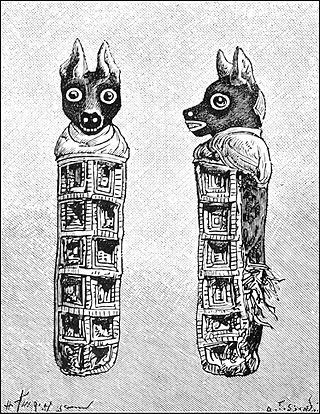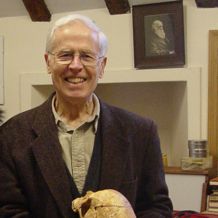Related Research Articles

Zooarchaeology or archaeozoology merges the disciplines of zoology and archaeology, focusing on the analysis of animal remains within archaeological sites. This field, managed by specialists known as zooarchaeologists or faunal analysts, examines remnants such as bones, shells, hair, chitin, scales, hides, and proteins, such as DNA, to derive insights into historical human-animal interactions and environmental conditions. While bones and shells tend to be relatively more preserved in archaeological contexts, the survival of faunal remains is generally infrequent. The degradation or fragmentation of faunal remains presents challenges in the accurate analysis and interpretation of data.

The Red "Lady" of Paviland is an Upper Paleolithic partial male skeleton dyed in red ochre and buried in Wales 33,000 BP. The bones were discovered in 1823 by William Buckland in an archaeological dig at Goat's Hole Cave which is a limestone cave between Port Eynon and Rhossili on the Gower Peninsula, near Swansea in south Wales. Buckland believed the skeleton was a Roman era female. Later, William Solace examined Goat's Cave Paviland in 1912. There, Solace found flint arrow heads and tools and correctly concluded that the skeleton was in fact a male hunter-gatherer or warrior during the last Ice Age.

The Gravettian was an archaeological industry of the European Upper Paleolithic that succeeded the Aurignacian circa 33,000 years BP. It is archaeologically the last European culture many consider unified, and had mostly disappeared by c. 22,000 BP, close to the Last Glacial Maximum, although some elements lasted until c. 17,000 BP. In Spain and France, it was succeeded by the Solutrean and by the Epigravettian in Italy, the Balkans, Ukraine and Russia.

Monte Verde is a Paleolithic archaeological site in the Llanquihue Province in southern Chile, located near Puerto Montt, Los Lagos Region. The site is primarily known for Monte Verde II, dating to approximately 14,550–14,500 calibrated years Before Present (BP). The Monte Verde II site has been considered key evidence showing that the human settlement of the Americas pre-dates the Clovis culture by at least 1,000 years. This contradicts the previously accepted "Clovis first" model which holds that settlement of the Americas began after 13,500 cal BP. The Monte Verde findings were initially dismissed by most of the scientific community, but the evidence then became more accepted in archaeological circles. The site also contains an older, much more controversial layer suggested to date to 18,500 cal BP, that lacks the general acceptance of Monte Verde II.

Environmental archaeology is a sub-field of archaeology which emerged in 1970s and is the science of reconstructing the relationships between past societies and the environments they lived in. The field represents an archaeological-palaeoecological approach to studying the palaeoenvironment through the methods of human palaeoecology and other geosciences. Reconstructing past environments and past peoples' relationships and interactions with the landscapes they inhabited provide archaeologists with insights into the origins and evolution of anthropogenic environments and human systems. This includes subjects such as including prehistoric lifestyle adaptations to change and economic practices.

The Upper Paleolithic is the third and last subdivision of the Paleolithic or Old Stone Age. Very broadly, it dates to between 50,000 and 12,000 years ago, according to some theories coinciding with the appearance of behavioral modernity in early modern humans. It is followed by the Mesolithic.

Donald Reginald Brothwell, was a British archaeologist, anthropologist and academic, who specialised in human palaeoecology and environmental archaeology. He had worked at the University of Cambridge, the British Museum, and the Institute of Archaeology of University of London, before ending his career as Professor of Human Palaeoecology at the University of York. He has been described as "one of the pioneers in the field of archaeological science".

The Boxgrove Palaeolithic site is an internationally important archaeological site north-east of Boxgrove in West Sussex with findings that date to the Lower Palaeolithic. The oldest human remains in Britain have been discovered on the site, fossils of Homo heidelbergensis dating to 500,000 years ago. Boxgrove is also one of the oldest sites in Europe with direct evidence of hunting and butchering by early humans. Only part of the site is protected through designation, one area being a 9.8-hectare (24-acre) geological Site of Special Scientific Interest, as well as a Geological Conservation Review site.
The Klasies River Caves are a series of caves located east of the Klasies River Mouth on the Tsitsikamma coast in the Humansdorp district of Eastern Cape Province, South Africa. The Klasies River Main (KRM) site consists of 3 main caves and 2 shelters located within a cliff on the southern coast of the Eastern Cape. The site provides evidence for developments in stone tool technology, evolution of modern human anatomy and behavior, and changes in paleoecology and climate in Southern Africa based on evidence from plant remains.

In archaeology, a biofact is any organic material including flora or fauna material found at an archaeological site that has not been technologically altered by humans yet still has cultural relevance. Biofacts can include but are not limited to plants, seeds, pollen, animal bones, insects, fish bones and mollusks. The study of biofacts, alongside other archaeological remains such as artifacts are a key element to understanding how past societies interacted with their surrounding environment and with each other. Biofacts also play a role in helping archaeologists understand questions of subsistence and reveals information about the domestication of certain plant species and animals which demonstrates, for example, the transition from a hunter-gatherer society to a farming society.
Norman Hammond is a British archaeologist, academic and Mesoamericanist scholar, noted for his publications and research on the pre-Columbian Maya civilization.
Howiesons Poort is a technological and cultural period characterized by material evidence with shared design features found in South Africa, Lesotho, and Namibia. It was named after the Howieson's Poort Shelter archaeological site near Grahamstown in South Africa, where the first assemblage of these tools was discovered. Howiesons Poort is believed, based on chronological comparisons between many sites, to have started around 64.8 thousand years ago and ended around 59.5 thousand years ago. It is considered to be a technocomplex, or a cultural period in archaeology classified by distinct and specific technological materials. Howiesons Poort is notable for its relatively complex tools, technological innovations, and cultural objects evidencing symbolic expression. One site in particular, Sibudu Cave, provides one of the key reference sequences for Howiesons Poort. Howiesons Poort assemblages are primarily found at sites south of the Limpopo River.

Guanche mummies are the intentionally desiccated remains of members of the indigenous Guanche people of the Tenerife. The Guanche mummies were made during the eras prior to Spanish settlement of the area in the 15th century. The methods of embalming are similar to those that were used by the Ancient Egyptians, though fewer mummies remain from the Guanche due to looting and desecration.

Paleofeces are ancient human feces, often found as part of archaeological excavations or surveys. The term coprolite is often used interchangeably, although coprolite can also refer to fossilized animal feces. Intact feces of ancient people may be found in caves in arid climates and in other locations with suitable preservation conditions. They are studied to determine the diet and health of the people who produced them through the analysis of seeds, small bones, and parasite eggs found inside. The feces can contain information about the person excreting the material as well as information about the material itself. They can also be chemically analyzed for more in-depth information on the individual who excreted them, using lipid analysis and ancient DNA analysis. The success rate of usable DNA extraction is relatively high in paleofeces, making it more reliable than skeletal DNA retrieval.

The Kow Swamp archaeological site comprises a series of late Pleistocene burials within the lunette of the eastern rim of a former lake known as Kow Swamp. The site is 10 kilometres (6 mi) south-east of Cohuna in the central Murray River valley, in northern Victoria, at 35.953553°S 144.318123°E. The site is significant for archaeological excavations by Alan Thorne between 1968 and 1972 which recovered the partial skeletal remains of more than 22 individuals.
Fiona Marshall is an archaeologist at Washington University in St. Louis. Her methodological specialties are zooarchaeology and ethnoarchaeology. She has excavated Pastoral Neolithic sites in eastern Africa, focusing primarily on the domestication and herding of animals, particularly cattle and donkeys. She has also conducted ethnoarchaeological research on factors that affect body part representation in archaeological sites, and on foraging ways of life amongst Okiek people of the western Mau Escarpment, Kenya. She has also worked to conserve the Laetoli footprints.
Mortuary archaeology is the study of human remains in their archaeological context. This is a known sub-field of bioarchaeology, which is a field that focuses on gathering important information based on the skeleton of an individual. Bioarchaeology stems from the practice of human osteology which is the anatomical study of skeletal remains. Mortuary archaeology, as well as the overarching field it resides in, aims to generate an understanding of disease, migration, health, nutrition, gender, status, and kinship among past populations. Ultimately, these topics help to produce a picture of the daily lives of past individuals. Mortuary archaeologists draw upon the humanities, as well as social and hard sciences to have a full understanding of the individual.

Iho Eleru, formerly known as Iwo Eleeru, is an archaeological site and rock shelter that features Later Stone Age artifacts from during the Late Pleistocene-Holocene transition, which is located in the forest–savanna village of Isarun in Ondo State, Nigeria. The site was initially discovered by Chief Officer J. Akeredolu, in 1961 during a large-scale survey of hilly landscapes around the town of Akure in Ondo State, Nigeria. The name was formerly and commonly known as Iwo Eleru, but the correct name is now regarded as Ihò Eléérú, or Iho Eleru, meaning "Cave of Ashes." The Iho Eleru skull is a notable archaeological discovery from the site which dates to approximately 13,000 years old. It may be evidence of modern humans possessing possible archaic human admixture or of a late-persisting early modern human.
Lawrence H. Keeley was an American archaeologist best known for pioneering the field of microwear analysis of lithics. He is also known for his 1996 book, War Before Civilization: The Myth of the Peaceful Savage. Keeley worked as a professor of archaeology at the University of Illinois Chicago.
The analysis of dental remains is a valuable tool to archaeologists. Teeth are hard, highly mineralised and chemically stable, so therefore preserve well and are one of the most commonly found animals remains. Analysis of these remains also yields a wealth of information. It can not only be used to determine the sex and age of the individual whose mandibular or dental remains have been found, but can also shed light on their diet, pathology, and even their geographic origins through isotope analysis.
References
- ↑ "Staff Profile: Professor Keith Dobney". The University of Sydney. Retrieved 26 February 2021.
- ↑ "Professor Keith Dobney: Curriculum Vitae" (pdf). The University of Sydney. 2018. Retrieved 26 February 2021.
- ↑ "Prof Keith Dobney BA; MSc; PhD". Department of Archaeology, Classics and Egyptology. University of Liverpool. Retrieved 26 February 2021.
- ↑ "Professor Keith Dobney". School of Geosciences. The University of Aberdeen. Retrieved 26 February 2021.